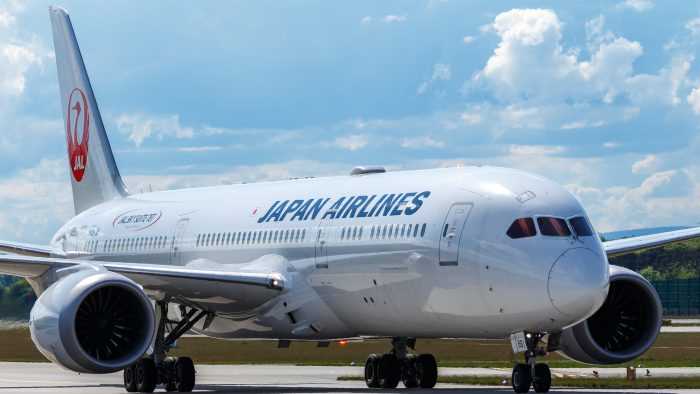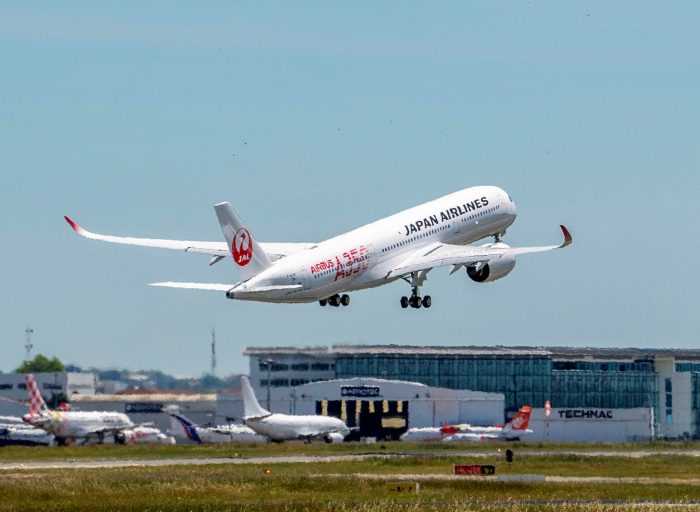
Japan Airlines will operate Dreamliners and A350s on domestic routes.
Japan Airlines are planning to operate their domestic network using two of the most popular and iconic widebody aircraft in the world today – the 787 Dreamliner and the A350. This is all part of the airline’s move to gear up capacity and quality of service in time for the 2020 Tokyo Olympics next year.
The A350 will start domestic service from September 1st, with more routes being added as more aircraft come into service. The 787s don’t have a confirmed delivery date yet, but the airline is anticipating deliveries starting in the autumn.
Widebodies on domestic routes
According to Anna Aero, Japan is leading the way in short haul widebody services, with an average of 4,719 widebody flights departing domestically each week over the summer of 2018. China and Hong Kong hold second and third place, with 4,378 and 1,452 weekly flights respectively. Tokyo’s Haneda airport is the one with the most widebody short haul flights in the world, handling around 1,918 per week.
Asia-Pacific in general are keen on widebody domestic routes, with 14 of the top 20 airlines for this type of service being based in this region. Fellow Japanese airline ANA are top of the pack, with 2,414 widebody domestic flights a week, and Japan Airlines are second with 1,758.

JAL operate more than 1,700 domestic flights a week with widebody jets.
The only European airline to make the top 20 domestic widebody carriers is Turkish, with 1,262 flights a week. Air Canada are the only one from North America in the top 20 list, with just 388 flights each week. Of course, there has recently been some talk about domestic widebody services in the UK and Australia, but these are one-offs rather than regular services.
While operating widebody aircraft domestically might seem bonkers in the west, the sheer number of travelers demanding airline services in Asia obviously makes it work. It’s a topsy-turvy strategy compared to what we see in the US, where hundreds of smaller flights take off every hour, giving passengers flexibility.
However, the real deciding factor here is the airport slots. Japan doesn’t have a lot of airports, and those it has aren’t particularly large. This means the slots are highly valuable, and airlines are keen to make the most of them. Haneda has recently opened new slots ahead of the 2020 Olympic games, which JAL are clearly keen to benefit from by throwing some massive planes into the space.
The JAL A350
JAL will be receiving their first A350 any minute now, as it was spotted taking its maiden flight just weeks ago.
Japan Airlines have given us a clear reason to be excited about their A350s. Not only is it the first Airbus to be ordered by the airline, but they are also one of very few carriers to offer a first class cabin on board. The debut route, from Tokyo Haneda to Fukuoka, launching on 1stSeptember 2019, will feature the ultra-premium cabin, and we can’t wait to see what it’s like.
Most operators of the A350 have chosen to drop the four class configuration, going instead for business, premium economy and economy only. There are a few exceptions, including China Eastern and Malaysia Airlines, although MAS recently rebranded their first class seating to ‘business suites’ instead.

JAL’s A350 taking its maiden flight last month.
However, according to Business Traveller, the JAL first class won’t be the luxurious standard that we’ve come to expect from them, and certainly not a patch on the lie flat, enclosed suites found on their 777ERs. This is somewhat understandable, as the airline will only operate the A350 on domestic flights. An odd decision, but interesting to see.
Although they aren’t revealing the interior until later this month, they have released a seat map, which clearly shows 12 first class seats in a 2-2-2 configuration, which is more akin to the seats on their 767s. However, with a 2-2-2 layout, there won’t be any throne seat. Sad times.

The seatmap for the A350.
The A350 is planned to fly between JAL’s hub at Tokyo and Sapporo, Okinawa and Osaka, as well as its launch route to Fukuoka.
The JAL 787
Japan Airlines are one of the biggest operators of the 787 worldwide, with a current fleet of 42. These are split between 25 787-8s and 17 787-9s.
On the 787-8, the airline has no less than three separate configurations. The long haul configuration has lie flat, staggered seats in business, and premium economy and economy cabins. The other two configurations both have angle flat business class seats and are used on regional routes.
The 787-9 has two configurations, both with lie flat business class seats and both with premium economy. The main difference is that one offers staggered business class seating and the other reverse herringbone. These are mainly used on longer missions.
As for their forthcoming domestic 787s, the details of the configuration has not yet been released. However, judging by their decision to include first class on the A350, we can assume there will be at least three classes on board. However, with shorter domestic trips their target mission, we reckon they’ll be angle flat rather than fully flat seats.
Currently only ANA use the Dreamliner on domestic routes, so it will be interesting to see another airline taking up the challenge. So far, we know the 787s are planned to operate the Tokyo Haneda to Osaka Itami route, and may run some other routes out of Osaka too. We’ll have to wait and see for the full schedule.
Upgrading the fleet
Japan Airlines will receive their first A350-900 later this week, although it’s not due to commence operations until September 1st. It’s the first of 18 they have on order, further complemented by 13 A350-1000s. The fleet of incoming A350s are all intended to replace their Boeing 777s, of which they have 40 in total.
The airline’s 777 fleet is split between -200s and -300s, which it uses on domestic routes, and -200ERs and -300ERs which are used for international travel. The A350-900s are slated to be used on domestic routes; we presume the -1000s will be intended for this market also, but with no firm date set for delivery, that remains to be seen.

The A350 will replace Japan Airlines’ fleet of 777s.
The airline also has options for a further 25 Airbus A350s, which it could leverage in the not too distant future to add more capacity to its domestic routes.
In terms of international replacements, the carrier already has 25 787-8s and 17 787-9s which are configured for long haul operations. However, the airline still has three 787-9s and four 787-8s due to be delivered. It is some of these which are headed for the domestic market.
The airline told Air Transport World that they would be using the four 787-8s yet to be delivered as domestic workhorses. They expect to begin receiving these in the autumn.
Simple Flying










